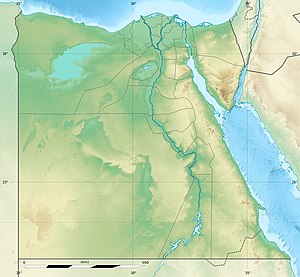Khufu
![]()
This article explains the pharaoh Cheops. For other meanings see Cheops (disambiguation).
![]()
Khufu is a redirect to this article. For the asteroid of the same name see (3362) Khufu.
Cheops (ancient Egyptian Chufu) was the second king (pharaoh) of the ancient Egyptian 4th Dynasty in the Old Kingdom. About his reign, which is dated to about 2620 to 2580 BC, and about his person exist only very few testimonies.
Cheops succeeded his father or stepfather, King Snofru, to the throne. He was the builder of the famous Pyramid of Giza, one of the Seven Wonders of the Ancient World. Cheops became famous primarily for his pyramid; very little is known about his life, reign, or any state-religious activities. So far, the only image of Cheops that has been preserved in its entirety is an ivory figurine about 7.5 cm tall, which was found in Abydos in 1903 and whose chronological classification is uncertain.
Otherwise, only fragments of any reliefs and statues remain, his temple complexes are only preserved as ruins or have disappeared. What is known about Cheops today comes from inscriptions in his necropolis and from much later written traditions. For example, he is the main literary figure in the narratives of the 13th Dynasty papyrus Westcar. Most of it has survived from the writings of ancient Egyptian and Greek historians.
Cheops' obituary presents itself altogether in ambivalent and not always easy to judge: While Cheops, at least in the Old and New Kingdoms, enjoyed cultic veneration and monument preservation and his reputation was maintained through literary works, the Greek scholars Manetho, Herodotus, and Diodorus drew an extremely negative character picture of him some 2000 years later. Thanks to these Greek authors, this rather critical to gloomy image of King Cheops has persisted until today.
Name
Cheops (Χέοψ Chéops) is the Greekized form of the name of the pharaoh handed down by Herodotus and Diodorus, who is also well known by his birth name Chufu (actually Chnum-Chuf(u)). Less common, Greekized variants of his name are Sûphís (Σοῦφις), attested by Manetho, and Sofe (Σόφη), transmitted by Flavius Josephus.
Lordship
|
| |||||||||||||||
| Sites of testimonies of Cheops |
Duration of government
There is uncertainty about the length of Cheops' reign. The royal papyrus Turin, which originated in the New Kingdom and is an important document on Egyptian chronology, mentions 23 years of reign, the Greek historian Herodotus 50 and the Egyptian priest Manetho, who lived in the 3rd century B.C., even 63. The highest contemporary attested date is a "17th time of counting" (meaning a nationwide census of livestock for the purpose of tax collection). An additional problem arises from the fact that these censuses were originally conducted every two years, but later some were conducted annually. Should a regular biennial census have taken place under Cheops, 34 reign years would thus be attested. Thomas Schneider assumes that the 23 years of reign in the Turin royal papyrus corresponded to biennial counts and that Cheops thus reigned for a total of 46 years.
Trade and expeditions
The only events from his reign that can be dated more precisely are three expeditions, two of which he sent to the surroundings of the oasis Dachla in the Libyan Desert and which served the procurement of pigments. According to rock inscriptions from the so-called "Water Mountain of Djedefre", located about 50 km west of Dachla, these expeditions took place in the "year after the 12th time of counting" (25th regnal year) and in the "year after the 13th time of counting" (27th regnal year). In 2011, a port complex was explored at Wadi al-Garf on the Red Sea, which, according to the pottery and inscriptions found, was founded in the early 4th Dynasty, probably already under Snofru. A heavily destroyed papyrus found here also names a "year after the 13th time of counting" of Cheops and is probably connected with an expedition to the Sinai Peninsula.
· 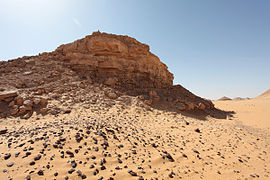
The "Water Mountain of Djedefre"
· 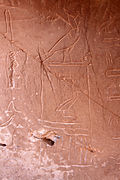
Inscription with Horus name of Cheops
· 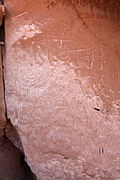
Inscription with names of the expedition leaders
Cheops is attested by undated graffiti in Elkab and on Elephantine, as well as in the quarries of Hatnub and Wadi Hammamat. His name is also attested outside the borders of Egypt at that time: In the diorite quarries at Gebel el-Asr west of Abu Simbel he had two stelae erected. A rock inscription in Wadi Maghara in the Sinai shows Cheops as the protector of the mines there. There is also evidence of trade relations with the Phoenician city of Byblos. Fragments of alabaster vessels and a copper axe bearing the name of Cheops have been found there.
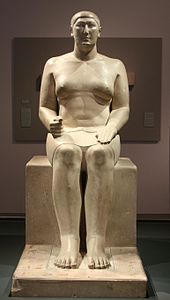
Statue of Hemiunu in the Roemer- und Pelizaeus-Museum Hildesheim
Questions and Answers
Q: Who was Khufu?
A: Khufu was a Pharaoh or leader of Ancient Egypt's Old Kingdom and the second pharaoh of the Fourth dynasty.
Q: When did Khufu rule Egypt?
A: Khufu ruled Egypt from around 2589 to 2566 B.C.E.
Q: What is one of Khufu's most famous accomplishments?
A: Khufu is thought to be the one who built the Great Pyramid of Giza, one of the Seven Wonders of the Ancient World.
Q: What was Khufu's full name?
A: Khufu's full name was "Khnum-Khufu" which means "the god Khnum protects me."
Q: What dynasty was Khufu a part of?
A: Khufu was a part of the Fourth dynasty of Ancient Egypt.
Q: What is the meaning of Khufu's full name?
A: The meaning of Khufu's full name, "Khnum-Khufu," is "the god Khnum protects me."
Q: How did Khufu's rule impact Ancient Egypt?
A: The Great Pyramid of Giza, built during Khufu's reign, represents the wealth and power of Ancient Egypt during his rule. It is also a symbol of Khufu's impact on Ancient Egypt's monumental architecture.
Search within the encyclopedia
